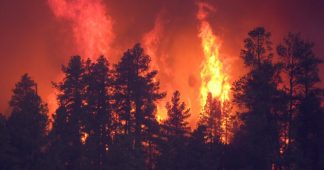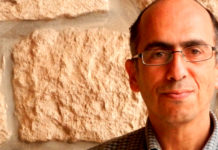1 August 2018
For the second year in a row, the US state of California is the scene of death and destruction, as wildfires surge throughout the state and drive thousands from their homes. In July alone, wildfires have killed nine people and burned over one thousand homes, forcing tens of thousands to evacuate.
The number of horrific tragedies is multiplying. On Thursday, Ed Bledsoe, 76, left his wife Melody, 70, and two great-grandchildren Emily and James, 4 and 5, to go to a doctor’s appointment. The Carr Fire had been burning for four days near his Shasta County home, but they were not under an evacuation order.
After a panicked call from his wife saying she could see the fire approaching, Bledsoe raced back, but was blocked by traffic and the encroaching fire. Unable to make it home, he managed to reach his family by cell phone as they huddled under wet blankets and the fire overtook them.
Their tragic deaths are part of the social catastrophe that surrounds every natural disaster. The stage is set by forces beyond mankind’s control, but these intersect with and are compounded by a social and political system in which everything is subordinated to the wealth accumulation of the corporate and financial elite.
At the same time as fires rage in California, the death toll from fires last week in Greece has risen to 91, with 25 still missing. While the immediate cause of these fires is still being investigated, there is no doubt that the austerity measures carried out by the Syriza government, dictated by European banks, are to blame for the massive death toll. They include cuts of 20 percent from the fire service, along with other cuts to utilities that contributed to electricity and water supply failures.
In California, prolonged drought conditions have dried out large sections of the state and provided large amounts of fuel for the ongoing fires. Of the ten most destructive wildfires on record in California, four have happened within the last ten months.
Last year, 43 people were killed in California fires, nearly 10,000 buildings were destroyed and a quarter-million people were evacuated. An investigation released last month found that a dozen of the fires that killed nine people in Northern California in October were caused by power lines operated by the Pacific Gas and Electric Company, highlighting the impact of decayed infrastructure in causing the blazes.
Among the factors contributing to the greater frequency and intensity of fires is climate change. Studies at the National Center for Atmospheric Research show that increased global temperatures have created warmer winters, shortening the amount of time needed for snowpack to melt, consequently also shortening the time for the newly created water to evaporate.
The Guardian cited University of California professor Anthony LeRoy Westerling, who noted that the impact of climate change “will probably accelerate. There won’t be a new normal in our lifetimes.” The Carr fire is only one of “a bunch of large fires which have behaved in uncharacteristic ways,” including “firenados” that have rapidly destroyed homes.
Similar trends are occurring in Europe and across the globe. Data from the Suomi NPP, Terra and Aqua satellites show Europe’s landscape turning from green to brown over the past month as a result of record long droughts in Armenia, Germany, Great Britain, Ireland and Norway. Approximately fifty forest fires, which have burned down 62,000 acres of land, were blazing in Sweden in mid-July.
Despite increasingly dire warnings from scientists about the consequences of climate change, the capitalist states—riven by national conflicts and each subordinate to the profits of giant corporations—have been incapable of taking any serious measures to do anything about it.
There are many factors that contribute to the spread of fires, and measures that could be taken to mitigate their impact. The US Forest Service estimates that in California’s wilderness there are an unusually high number of dead trees, 129 million, killed by drought and beetle infestations. That immense volume of fuel, reaching high into the canopy, intensifies and helps spread the fires that break out.
Residential building is carried out wherever individual developers can turn a profit. They carry no liability for long-term risks. Moreover, soaring housing costs have driven people to seek lower rents outside the cities in smaller towns and suburbs with greater risks. Cal Fire identified more than 1,300 communities in California “at high risk of damage from wildfire.” But that list was compiled from the 1990 census data and published in 2001. It has not been updated since.
Then there is the impact of perpetually underfunded and under-resourced fire departments, which have faced a series of budget cuts since the 2008 economic crisis. A full quarter of California’s wilderness firefighters are prison inmates who are paid $1 an hour when actively fighting fires and $2 a day when doing preventive work. Two of these workers died in the 2017 fires.
As for the impact of the fires, as with other natural disasters, those who have had their lives upended are left at the mercy of insurance companies, if they even have insurance. Bledsoe, who lost his family, was a renter without insurance. The only thing he has left after the fire is his truck and the clothes on his back. Only a GoFundMe page set up by a family friend separates him from complete destitution.
Resources exist to take emergency measures to address the conditions that produce such disasters. California’s current emergency fund for wildfires is $442.8 million, and a full quarter of it was spent since July 1, $114.7 million. In contrast, every two days in 2018 Jeff Bezos, the CEO of Amazon and richest man in the world, made more than that, $510 million. The entire budget of Cal Fire, which manages the 31 million acres of California’s wilderness, is roughly what Bezos makes in a week.
In a socialist and planned economy, billions would be allocated to implement scientific fire prevention and controlled burning methods. Resources would be devoted to construct advanced warning systems and evacuation routes. Everyone would have access to modern housing in developments planned from the start to avoid wildfires. Those who, despite all these precautions, lost their homes would be made whole with new housing. And emergency measures would be taken, on a global scale, to halt and reverse climate change.
Every natural disaster exposes the social and political reality. As the California fires rage, the Trump administration is plotting new ways to hand out billions in tax cuts to the rich. The Democrats, who control the state of California, are focusing all their efforts on denouncing Trump for being insufficiently aggressive against Russia, while ensuring that the military is funded with a gargantuan $716 billion budget.
The entire political establishment, indifferent and hostile to the interests of the vast majority of the population, merely exposes its own bankruptcy and the irrationality of the capitalist system over which the ruling class presides.
David Brown











